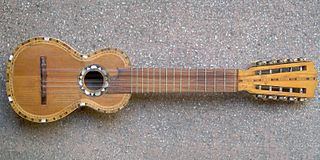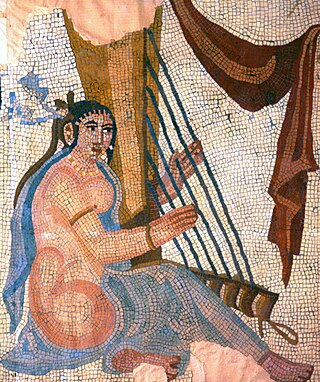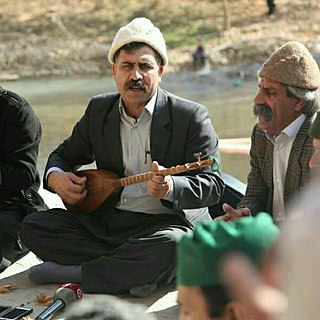
The lyre is a stringed musical instrument that is classified by Hornbostel–Sachs as a member of the lute family of instruments. In organology, a lyre is considered a yoke lute, since it is a lute in which the strings are attached to a yoke that lies in the same plane as the sound table, and consists of two arms and a crossbar.

The charango is a small Andean stringed instrument of the lute family, from the Quechua and Aymara populations in the territory of the Altiplano in post-Colonial times, after European stringed instruments were introduced by the Spanish during colonialization. The instrument is widespread throughout the Andean regions of Bolivia, Peru, Ecuador, northern Chile and northwestern Argentina, where it is a popular musical instrument that exists in many variant forms.

The rebec is a bowed stringed instrument of the Medieval era and the early Renaissance. In its most common form, it has a narrow boat-shaped body and one to five strings.

The crwth, also called a crowd or rote or crotta, is a bowed lyre, a type of stringed instrument, associated particularly with Welsh music, now archaic but once widely played in Europe. Four historical examples have survived and are to be found in St Fagans National Museum of History (Cardiff); National Library of Wales (Aberystwyth); Warrington Museum & Art Gallery; and the Museum of Fine Arts, Boston (US).

The rich and varied music of Sudan has traditional, rural, northeastern African roots and also shows Arabic, Western or other African influences, especially on the popular urban music from the early 20th century onwards. Since the establishment of big cities like Khartoum as melting pots for people of diverse backgrounds, their cultural heritage and tastes have shaped numerous forms of modern popular music. In the globalized world of today, the creation and consumption of music through satellite TV or on the Internet is a driving force for cultural change in Sudan, popular with local audiences as well as with Sudanese living abroad.
Music has been an integral part of Egyptian culture since antiquity in Egypt. Egyptian music had a significant impact on the development of ancient Greek music, and via the Greeks it was important to early European music well into the Middle Ages. Due to the thousands of-years long dominance of Egypt over its neighbors, Egyptian culture, including music and musical instruments, was very influential in the surrounding regions; for instance, the instruments claimed in the Bible to have been played by the ancient Hebrews are all Egyptian instruments as established by Egyptian archaeology. Egyptian modern music is considered as a main core of Middle Eastern and Oriental music as it has a huge influence on the region due to the popularity and huge influence of Egyptian cinema and music industries, owing to the political influence Egypt has on its neighboring countries, as well as Egypt producing the most accomplished musicians and composers in the region, especially in the 20th century, many of them are of international stature. The tonal structure music in the East is defined by the maqamat, loosely similar to the Western modes, while the rhythm in the East is governed by the iqa'at, standard rhythmic modes formed by combinations of accented and unaccented beats and rests.
Arabic music is the music of the Arab world with all its diverse music styles and genres. Arabic countries have many rich and varied styles of music and also many linguistic dialects, with each country and region having their own traditional music.

Scotland is internationally known for its traditional music, often known as Scottish folk music, which remained vibrant throughout the 20th century and into the 21st when many traditional forms worldwide lost popularity to pop music. Traditional Scottish music comprises a variety of different styles such as ballads, reels, jigs and airs. Traditional Scottish music is closely associated with the bagpipes which is credited as having a prominent role in traditional music originating from the country. The bagpipes are considered an "iconic Scottish instrument" with a history dating back to the 15th century. Other notable Scottish instruments include the tin whistle, the accordion and the fiddle.

The traditional music of Jordan has a long history. Rural zajal songs, with improvised poetry played with a mijwiz, tablah, arghul, oud, rabab, and reed pipe ensemble accompanying is popular. The transition of old cultural music into hit pop songs known worldwide. Recently, Jordan has seen the rise of prominent DJs and pop stars.
The music of Lebanon has a long history. Beirut, the capital city of Lebanon, has long been known, especially in a period immediately following World War II, for its art and intellectualism. Several singers emerged in this period, among the most famous Fairuz, Sabah, Zaki Nassif Wadih El Safi, Nasri Shamseddine, Melhem Barakat, Majida El Roumi, Ahmad Kaabour, Marcel Khalife, and Ziad Rahbani, who—in addition to being an engaged singer-songwriter and music composer—was also a popular playwright.

The Djiboutian Music refers to the musical styles, techniques and sounds of Djibouti. The first major form of modern Djiboutian music began in the mid-1940s, when Djibouti was a part of the French Somaliland. Djiboutian music is characterized by poetry, so that listening to a Djiboutian song is first paying attention to its meaning. The artist rocks the listeners in the cheerfulness of the refrains and the turn of the sentences. Often sung by a couple, a song is played in the form of a sleight of hand between a man and a woman, one recounting his feelings and his love, even his passion for the other, until the other accepts or rejects this offer.

Ancient music refers to the musical cultures and practices that developed in the literate civilizations of the ancient world, succeeding the music of prehistoric societies and lasting until the post-classical era. Major centers of ancient music developed in China, Egypt, Greece, India, Iran/Persia, the Maya civilization, Mesopotamia, and Rome. Though extremely diverse, the music of ancient civilizations is frequently characterized by monophony, improvisation, and the dominance of text in musical settings.

The jouhikko is a traditional, two- or three-stringed bowed lyre, from Finland and Karelia. Its strings are traditionally of horsehair. The playing of this instrument died out in the early 20th century but has been revived and there are now a number of musicians playing it.

The term Tanbur can refer to various long-necked string instruments originating in Mesopotamia, Southern or Central Asia. According to the New Grove Dictionary of Music and Musicians, "terminology presents a complicated situation. Nowadays the term tanbur is applied to a variety of distinct and related long-necked lutes used in art and folk traditions. Similar or identical instruments are also known by other terms." These instruments are used in the traditional music of Iran, Iraq, India, Armenia, Afghanistan, Azerbaijan, Pakistan, Turkey, Tajikistan, Kazakhstan, and Uzbekistan.

The tanbūra or "Kissar" is a bowl lyre of East Africa and the Middle East. Tanbūra traces its etymology to the Persian tanbur via the Arabic tunbur, though this term refers to long-necked lutes. The instrument probably originated in Upper Egypt and the Sudan in Nubia and is used in the Fann At-Tanbura in the Persian Gulf Arab States. It also plays an important role in zār rituals.

The simsimiyya is a box or bowl lyre used in Egypt. Models exist with both circular soundboxes as well as rectangular. In the past, Egyptian models had 5 strings. The strings are held in place by pegs instead of tuning rings. Today, images of the instrument in Egypt may show 12 strings. It's been played since ancient times
The Kemençe of the Black Sea is a Greek and Turkish traditional musical instrument. It belongs to the category of stringed bowed musical instruments. It has three strings, usually tuned to perfect fourths, usually tuned B-E-A. It is the pre-eminent musical folk instrument of the Greeks of Pontus. It seems to have been invented during the Byzantine years, between the 11th and 12th centuries. The instrument is made of different types of wood.
Contemporary art in Egypt refers to visual art, including installations, videos, paintings, or sculptures, developed in the Egyptian art scene. While the contemporary art scene is mainly concentrated in Cairo and Alexandria, it is developing fast with the emergence of spaces for artists, and support from the public or from abroad. Many Egyptian artists use the Egyptian contemporary art scene as a ramp toward the international art scenes.

Music technology is the study or the use of any device, mechanism, machine or tool by a musician or composer to make or perform music; to compose, notate, playback or record songs or pieces; or to analyze or edit music.

Mechanical music technology is the use of any device, mechanism, machine or tool by a musician or composer to make or perform music; to compose, notate, play back or record songs or pieces; or to analyze or edit music. The earliest known applications of technology to music was prehistoric peoples' use of a tool to hand-drill holes in bones to make simple flutes. Ancient Egyptians developed stringed instruments, such as harps, lyres and lutes, which required making thin strings and some type of peg system for adjusting the pitch of the strings. Ancient Egyptians also used wind instruments such as double clarinets and percussion instruments such as cymbals. In Ancient Greece, instruments included the double-reed aulos and the lyre. Numerous instruments are referred to in the Bible, including the horn, pipe, lyre, harp, and bagpipe. During Biblical times, the cornet, flute, horn, organ, pipe, and trumpet were also used. During the Middle Ages, hand-written music notation was developed to write down the notes of religious Plainchant melodies; this notation enabled the Catholic church to disseminate the same chant melodies across its entire empire.















